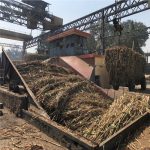Too many things on the table
After the sharp drop during the week, the sugar futures market in NY strongly recovered at last Friday’s session and closed out rigorously unchanged against the previous week.
The week in the Big Apple was bustling due to the Sugar Gala Dinner in NY, the first one after the pandemic, and the circles at the cocktails with lots of whisky going around while the guests presented their bullish and bearish thesis to suit all tastes and alcoholic degree were particularly excited. The market must have been captivated by the ethylic breath dominating the social gathering and behaved pretty erratically over the week.
May/2022 futures contract closed out at 19.19 cents per pound and just about all of the months until March/2024 closed out unchanged. The real closed out the week at a slight appreciation against the American currency. So, the closing values of NY converted into real and adjusted by the domestic interest rates ended up showing a slight R$10-per-ton drop for the current crop and were unchanged for 2023/2024 and 2024/2025.
The funds reduced the long position to a little over 92,000 lots after selling 18,000 contracts in the report published by COT (Commitment of Trades) which takes into account last Tuesday’s open position against that of the previous one.
The numbers of the sugarcane crushing in the Center-South recently published by UNICA light up a warning sign to the real possibility of a reduction in sugarcane production this crop. Many consulting firms have been reducing their production estimates already reflecting the performance seen by the mills at this start of the crushing.
Archer Consulting has reduced its sugarcane production estimate for 2022/2023 in the Center-South to 548 million tons (the previous one was 552 million) also reducing the ATR by a little more than a kilo per sugarcane ton, which adjusts the sugar production to 31.5 million tons, 525,000 less than last year.
The production mix, as expected, should prioritize ethanol in 56.2% and puts the forecast of fuel production at 25.4 billion liters which together with corn ethanol add up to 29.8 billion liters, out of which 11.5 billion liters are anhydrous and 18.3 billion liters are hydrous. There are some mills that will increase ethanol production by more than 10 percentage points against that of the last crop.
In thesis, a smaller production of sugar in Brazil should cause a high on the product quotation at the NY exchange and the inversion – though small – on the first futures contracts traded there. It turns out that Brazil, greatest exporter of the product, strongly jumped the gun more than a year ago and sold and fixed prices for an export volume larger than 20 million tons for this crop.
So, unless the mills rush to cancel these sugar deliveries through washouts to take advantage of a better fuel compensation, a possible but not probable situation, the sugar supply is guaranteed. However, market rumors have it that about 300,000 tons of sugar could shift to ethanol with the approval of the trading houses.
The devaluation of the Indian rupee, sugar price hikes on the futures market of NY in the first four-month period this year and the fact that India has had a production above the expectations encouraged the country to speed up its sugar exports taking advantage of profitable prices and flooding the world with almost 10 million tons to be shipped up until the end of the crop. And all this despite the country having so far directed 3.5 million tons of sugar equivalent for the ethanol production and the recovery of the domestic consumption, which jumped from 26.5 to 27.8 million tons.
Next crop, India should continue with the successful strategy it used this crop fixing export prices in NY before even producing as other origins do. The volume is not meaningful, but they are more aware of the market and risk management, common effect when the subsidies vanish. The trend is for this behavior to remain.
With inflation undermining the world and the interest rates trying to fight it, it’s normal for household consumption to drop and food industries to reduce their stocks and put off possible replacements. On the other hand, Brazilian producers are worried about the production cost of this present crop (some have magically added an increase of 12% to the budget) and have no idea how much the 2023/2024 crop cost will be.
The logic of interrupting possible export sugar pricing next year is based on the impossibility of foreseeing so many variables under so many world uncertainties (the length of the war, logistic costs, inflation rate, interest rate, global economy) intensified by the domestic uncertainties (elections, Petrobras leadership, exchange rate, climate issues).
We will all need more time to make a decision. The general picture is pretty volatile and complex. It will have to be one day at a time. However, I believe that from the start of the second semester on, we will be able to have more favorable winds for sugar prices on the foreign market if the much talked about reduction in crushing, the lack of sugarcane field expansion due to the migration to other cultures, the change (though slow) in the energy matrix of the post-war world that favors green fuels come true. There are many things on the table.
You all have a nice weekend.
To read the previous episodes of World Sugar Market – Weekly Comment, click here
To get in touch with Mr. Arnaldo, write on arnaldo@archerconsulting.com.br












